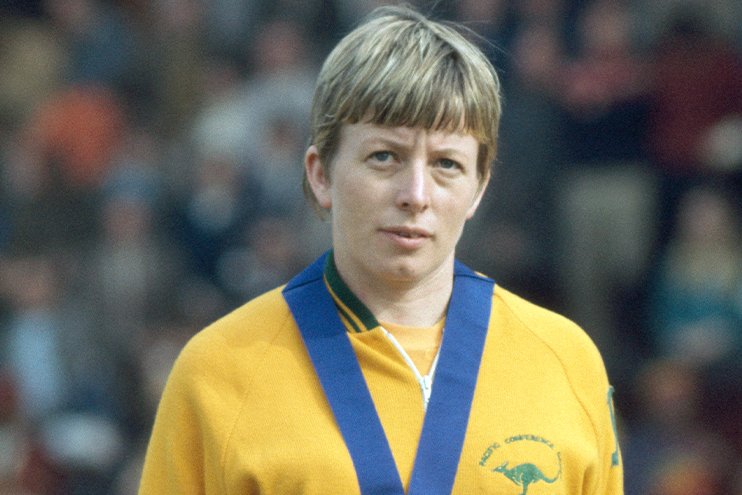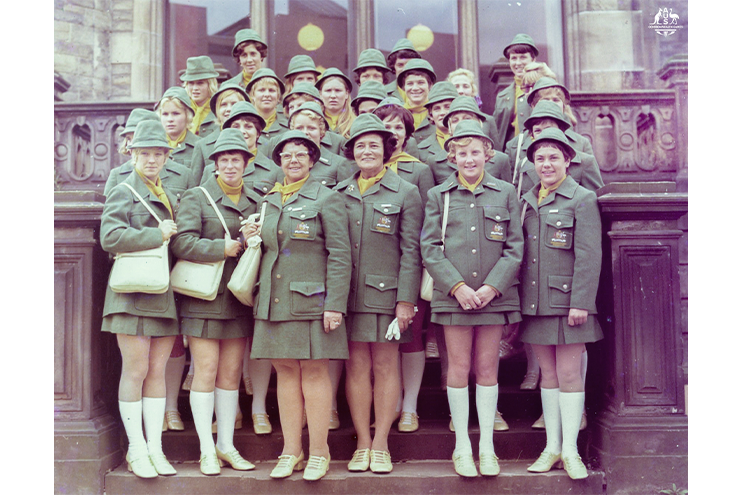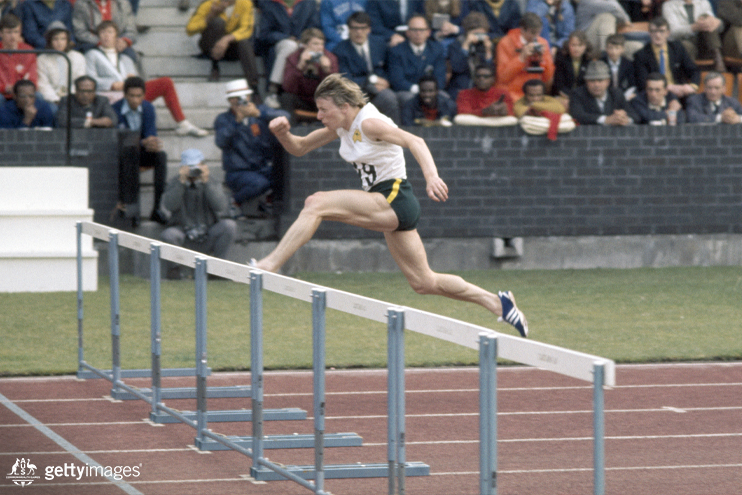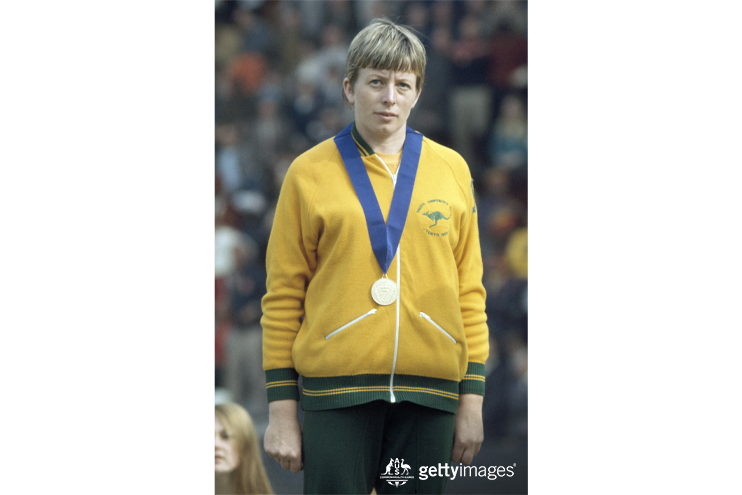
By Ian Hanson
The name Pam Kilborn is synonymous with track and field success in Australian sport.
A famous name from the 1960s and ‘70s who sticks in your mind, the little hurdler with the bulldog tenacity and determination, a two-time Olympic medallist and Commonwealth Games legend.
You can still picture Pam bounding over those hurdles – and alongside Olympic champion Maureen Caird, together the duo paving the way for her modern-day hurdling successor Sally Pearson.
But time gets away and it’s not until a milestone emerges from those halcyon days that you start to wonder…. whatever happened to some of our precious gems of the past?
This week marks 50 years since Pam led the Australian Commonwealth Games team around Edinburgh’s Meadowbank Stadium at the 1970 British Empire Games, proudly carrying the Australian flag – the first woman to be bestowed with the honour from any previous Commonwealth or Olympic Games.
And after two successful Olympic campaigns, where she had won bronze in Tokyo in ’64 and silver in Mexico in ’68 over the 80m hurdles, and four gold medals from two previous Commonwealth Games in Perth in ’62 and Kingston in ’66, there were no better credentials for our flagbearer than the world’s fastest hurdler.

Pam Kilborn leading out the Australian team at the Edinburgh 1970 opening ceremony. (CGA Archive)
And the little bull-at-a-gate hurdler continued to write her way into the history books taking her Commonwealth Games gold medal tally to six with a memorable 1970 Games in Edinburgh.
The now 80-year-old recalls, despite her Olympic feats, it is the Commonwealth Games which remains closest to her heart.
“The Edinburgh Games actually had so much happening for me; I remember them with great joy really, because I think the Commonwealth Games are the better Games as far as making friends and enjoying yourself are concerned,” she said as her mind wandered down an extraordinary memory lane from her home now in the Melbourne suburb of Montmorency and back to the tartan track of Edinburgh.
“I just found the Olympic Games, that I was so bogged down with East Germans running against me then the only race that didn’t have an East German in it was Mexico in ’68 and it had Maureen Caird.
“They were the better Games, or maybe I just did better at the Commonwealth Games than the Olympics and athletics had good results in Edinburgh and Perth.
“Edinburgh was really a great Games and it would be good to go back to Scotland and have a good look around… they are such nice people and I have the fondest of memories.”
Being named as the flagbearer was certainly one of the proudest moments of her extraordinary career, although filled with trepidation, nervousness, and even embarrassment – as she led the Australian team from a practice march in the Village using a cleaner’s mop as the flag into the main stadium.
It was also the era of the mini-skirt and Pam recalled what the female team had to go through to ensure the dress regulations were all in order.
“We all had to kneel on the ground in our gold dresses and it had to be no more than 2 or 3 inches above the knee when kneeling,” Pam said.
“And it took half the morning for the Australian girls to do all that and come the day of the Opening Ceremony and carrying the flag and you can just picture the scene.
“We had to walk past the grandstand at Meadowbank with Prince Philip, the Duke of Edinburgh, and all the dignitaries sitting there, and I had to lift the flag straight above my head and then drop it so it didn’t touch the ground when it went out horizontally.
“But when you lift your arm directly above your head and you have a mini skirt on two to three inches above the knee it climbs up and all I was conscious of was my mini skirt that was far too short to have my hands above my head with thousands of fans in a packed grandstand… I was afraid of what might happen in front of all those people.
“When I lifted the flag up the men had to take their hats off and hold them out to the side and then place them across their chests with their eyes right.
“I didn’t know whether that performance by the men was making the crowd scream and clap or whether it was my mini skirt and the contents of my underpants making the crowd shout… I was so embarrassed.
“But it was such a memorable day; you wouldn’t have it these days; the skirts can be long or short and it doesn’t matter what you wear underneath it’s a case of whatever nowadays!
“It was a great Games; I was selected for the hurdles and the relay and we went straight from Australia across to Scotland but I hadn’t had any competition and of course it was winter in Australia.”

The Australian female athletes in their formal uniform for the 1970 Games. (CGA Archive)
Keen to get some runs on the board, Pam applied to compete in the pentathlon as well – a five-event pentathlon in those days, later replaced by the seven-event heptathlon which it is today.
“I was given permission to have a run in the pentathlon 100m hurdles and another race over 200 metres for some much-needed lead up runs,” Pam said.
“The first day of the pentathlon was freezing, like a Melbourne morning in the middle of winter, about 5 degrees and this was in their summer.
“It was bleak, a freezing cold day, an arctic wind blowing across the track.
“Anyway, I did the hurdles, the 200 and the shot put and then went to the high jump.
“I was half-way through and I thought to myself ‘this is stupid’, although I would probably get a medal in it because I was leading at the time.
“But I am so cold I couldn’t feel my fingers or toes or anything… maybe after the high jump which finished the first day’s competition, I’ll pull out, so I did.
“But when I entered the pentathlon the other two hurdlers Maureen Caird and Penny Gilles (McCallum) also entered.
“I don’t high jump very well because I’m too short… I’m only 5ft 2in (1.57m) and I could just high jump 5ft 2in… and that finished me off.
“Everyone else gets up to 5ft 7ins 5ft 8ins (1.70m/1.72m)… so when I pulled up at the high jump, halfway through the competition… Maureen and Penny decided they would pull out too and it caused an absolute upset and furor.
“They brought in a rule from then on that no competitor would be allowed to withdraw from any competition and if you do so, then you would have to have a doctor’s certificate and if you didn’t have a good reason you are out for the rest of the competition, for those Games and maybe the next Games as well.
“So we created the biggest distraction of the Games. I wanted to pull out quietly myself but Maureen and Penny were not having a bar of that and they pulled out too.
“It led to a major change to athletics rules didn’t it?”
The girls all then turned out in their specialist hurdles with all the talk about whether Pam could beat the reigning Olympic champion Caird over the longer 100m after the pair went head-to-head for gold and silver just two years earlier.

Pam Kilborn in full flight in the 100m hurdles. (Getty Images)
But this time it was Kilborn who created her slice of history, winning her third hurdles title from three Games, and reversing the result from Mexico.
In doing so, Pam Kilborn became the first female in any sport to win three consecutive gold medals in the same event at the Commonwealth Games.
Kilborn would later add a second gold medal running in 4x100m relay team with Raelene Boyle, Jenny Lamy and Marion Hoffman, but when asked about her main event, Kilborn seemed to downplay her tremendous achievement.
“It was another hurdles final. I won and the other two came second and fourth,” Kilborn said.
“The Commonwealth Games wasn’t that much of a competition in hurdles and to be truthful I didn’t worry too much about getting a medal.”
But despite her humility, Pam Kilborn was one of the stars of the 1970 Games.
After the Closing Ceremony, Pam was heading to Europe to continue the athletics season but did not expect what was to happen next on the morning of her departure.
“The nicest thing happened to me as I was leaving the Village; unbeknown to me there was a Scottish piper dressed in all his traditional Scottish regalia and he piped me out of the Village,” Pam recalled.
“Right down the road he went and walking in front of the car I was in – truly an amazing farewell.
“It was such a great Games, it was so nice.”
Pam Kilborn wins the Women’s 100m hurdles final. (CGA Archive)
Returning from a brief retirement, Kilborn recorded a fourth placing at the 1972 Munich Games, before retiring for good, having achieved world records, an Olympic medal and six Commonwealth Games titles.
Such was her ability, her national hurdles record of 12.93 seconds set in 1972 was not eclipsed until Sally Pearson shaved just .01 off the time in 2007.
These days, the champion hurdler has lost a little of the spring from her step. After retiring from athletics and turning her hand to coaching where she guided a generation of young athletes, she has been forced away from her beloved track and her training squad because of ill-health… hurdles she didn’t expect or deserve.
“I had to give up coaching two years ago and I confronted my squad and said I couldn’t coach anymore,” said Pam, who is now housebound suffering from three cancers, including Lymphoma as well as Sarcoidosis – an autoimmune disease.
“I just couldn’t do it anymore and I’ve gone from being a coach, running around the world with my kids and coaching so many nights a week.
“I am now virtually housebound and have a carer who looks after me.
“My life has changed in [the last] two years… I just like to be able to do stuff and I can’t and when your whole life has been around sport and you can drive a car and do what you want and go overseas and now you can’t get out and you struggle to walk, it is a big hit to the system.
“But it’s good to reminisce, especially about the Commonwealth Games.
“I still have my Commonwealth Games travelling uniform from Edinburgh, a tweed suit, really nice to go there in something warm.
“I thought maybe the straight legs of the slacks will come back in fashion but then every time I look at it… I think it’s just so 1970s.”
And her health?
“Look, it’s going not too badly,” said Pam, putting on a very brave face.
“I had a check-up for my Lymphoma [recently] and I’m still in remission which is good and my other cancers are going fairly well.
“But I also have that Sarcoidosis, which is a bit of a nuisance, it slows me down a bit but I’m doing alright… I guess… taking it day by day… every day’s a new day.”
Pam Kilborn, AM, MBE, Olympian – Commonwealth Games hero – is still showing what that bull terrier determination can do when life throws some unexpected hurdles you certainly don’t deserve.

